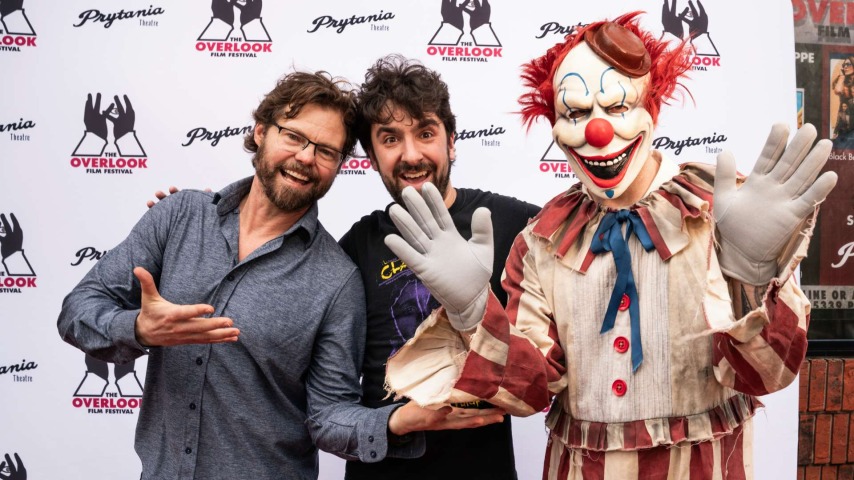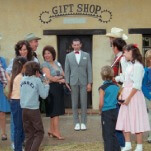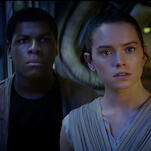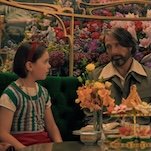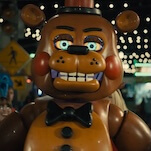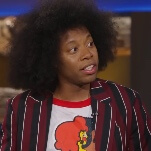Clown In A Cornfield isn’t the first circus-themed horror movie piling out of the clown car, but it might be the funniest. The story of the new girl in a decaying Midwest town who joins a clique of horror-obsessed YouTubers, Clown In A Cornfield turns American rot and the generational divide into bloody good satire, dripping with corn syrup. Directed by Eli Craig with the same playful energy of his meta breakthrough, Tucker & Dale Vs. Evil, Craig finds the funny in horror clowns again. Art and Pennywise turn japes into kills, but Craig shucks something more meaningful and American in this cornfield.
Every element of Clown In A Cornfield is a genuine surprise, from its origins as a YA bestseller to its grisly horror that cuts bone deep. It’s a classical slasher with enough charm to comment on tropes and stage meta-sequences without letting the air out of the balloon, infused with a casual confidence that Craig also brings behind the camera. More than a decade after Tucker & Dale, Craig returns to slashers with a straighter face but tongue still planted in cheek.
The A.V. Club spoke with Craig following a screening of Clown In A Cornfield at the Overlook Film Festival.
The A.V. Club: Clowns have been at the center of horror for almost a decade now, between It and Terrifier, but also Joker. Why are clowns resonating with people right now? What made your version unique?
Eli Craig: Look at America. Look at our culture. Clown In A Cornfield is a metaphor for America. Corn is very much American. It’s an American crop, and the Midwest is full of cornfields. And clowns are also very Americana. What I loved about this version of a clown was that it’s based on something real. We looked at these old Lon Chaney—The Man Of A Thousand Faces—clowns, like this old ’30s American Gothic feel. I thought there was a new original take on clowns, that [my movie] could enter into the world of clown feature films, and be its own thing. Like, Frendo is really his own person. People always compare us, probably, to Art or Pennywise, because they’re both clowns, but this is just a totally different type of clown, and he’s more symbolic of something very American than I wanted to do.
AVC: Clown In A Cornfield focuses on corn syrup because the clown is a corn syrup company mascot. Not only is corn syrup a symbol of American rot, but it’s an integral part of horror filmmaking, because all of the blood is corn syrup. What does corn syrup mean to you?
EC: Also, popcorn gets a popcorn movie. There are all these elements of corn syrup being this duality of American culture. It calls back to the 1940s and ’50s when America was this surging economy, and the Rust Belt was thriving. Corn syrup was viewed as a cure-all. Kids would take corn syrup, a spoonful of it every morning, to help them grow healthier and stronger bones. You’ll see these old commercials about how healthy cereal and corn syrup were for you. All of that has sort of rotted and disintegrated. We’ve seen this duality of American culture where there’s the manifest destiny and the looking forward to a better future, and then the decadence, America disintegrating, or at least the American dream really disintegrating. So that duality was something I wanted to play upon in this movie.
Kettle Springs has…an aesthetic of this: old rusted-out trucks, blue-collar America. This is a part of America I really adore and love, and I wanted to show it in an authentic light. Will Sasso, who plays the sheriff, grounds it. He’s such a likably awful character. There’s something lovable about the guy, even as he’s this awful sheriff. It was important to make Kettle Springs both a cozy, lovable place, but also a very threatening place.
AVC: The movie is satirical but not overly pushy with the messaging. Was it a tricky balance to strike?
EC: That is the job for me. That’s what I love: movies that have something to say but don’t hit you over the head with it, and you maybe have to think about it for a second, because you’re so entertained that it doesn’t seem like the filmmaker’s trying to say something. [Tucker & Dale Vs. Evil], to me, is a treatise on classism in American culture and the arrogance of the elite looking down on the underprivileged. But almost nobody thinks of that when they see Tucker & Dale because it’s a farce, and I love films that have layers upon layers of meaning. So if I can get somebody to think more deeply about the film and dissect it, that’s fantastic, but if somebody just comes and enjoys the ride, that’s cool, too.
AVC: Tucker & Dale was a meta slasher, where the horror movie happens behind the characters’ backs. Clown In A Cornfield is more classical. Was it intimidating to play it straight?
EC: To be honest with you, I was intimidated to make a movie at all again after Tucker & Dale. I went and made the movie I wanted to make, and I found it to be really funny, but I wasn’t sure I was really a horror guy. I was more of a comedy guy. And as I’ve gotten older, I’ve fallen more in love with horror, and the world is just more horrific, and I’m a little angrier than I was back then. I harnessed all these parts of myself and put the ugliness of the serial killer up front in this movie. I guess I didn’t feel like I needed to be as funny all the time. I wanted the kills to play gory and real and horrific, and then have the humor be a release valve after that.
AVC: What was it like working with such a young group of actors? Was it different from your other work?
EC: Even Tucker & Dale, we had the young cast too. When I did Little Evil, yes, it was Adam Scott. He was a seasoned pro, but also young Owen Atlas.
I love working with actors. I worked as an actor for a bit myself. I was raised by an actor. I’m very familiar with the process of acting. I studied it for a long time. Ultimately, [acting] wasn’t for me because I don’t really like performing. I like recording other people performing. But I love acting, and I love actors, and helping them find that comedic moment. Rehearsal is also important to me. Sometimes I see directors and they don’t want to talk to actors or they’re sort of scared of their task, but I’m really in there with them, helping them all along the way.
AVC: The main characters are horror filmmakers who know genre tropes. Late in the movie, one character, aware of how these things usually go, says she’s next to die. How do you sustain the tension while also calling attention to it?
EC: Sometimes when you’re doing something tropey, it’s better to call attention to it and poke fun at it. I cast these actors, and then all of a sudden you realize, no spoilers, but you realize you’re killing people in orders that correspond to ’80s slasher movies. I love that it’s a big laugh in the movie because I wrote that, like, the day before we shot it.
But as far as the kill goes, I wanted some of the kills to just be like a real shock. There’s this build-up of feeling like maybe they’re getting away, or you’re not sure where in the corn the clown is. It could be here or there. There’s this feeling of claustrophobia inside a cornfield that I wanted to get into with a camera, that you just don’t know where anything is. And so when that kill happens, it’s a bit of a jolt. But when she says she knows she’s going to die, you’re like, “Well, you’re probably not going to be the next to die.” So it is a surprise when she gets it.
AVC: You tell the audience what’s going to happen and then surprise them anyway.
EC: Nobody believes you when you tell them. You say exactly what you’re going to do, and then for some reason, they won’t believe you if you say that. It’s like the opposite of a reversal. It’s like setting up a reversal, but then not reversing it, and that also works as a reversal.
AVC: After the screening last night, you said you saw yourself more as an action filmmaker than a horror filmmaker. This movie has a lot of action, particularly in the finale. What do you love about directing action?
EC: I always wanted to do action movies. My first loves were always Terminator 2 and Aliens. Big action movies. And [Clown In A Cornfield] is a very small budget, but you’re playing with suspense in these action elements. When you have a big stunt, like a car smashing through a wall, it takes half a day, and you have to really set up for the stuntwork. But that, to me, is the fun of filmmaking. That’s the greatest. I get so much joy out of those action moments and trying to keep the pacing and tempo up of the film. Hopefully, one day I’ll get the money to make more of an action-horror movie, or action-comedy, but I have to do it with much less budget than some directors.
AVC: The action and stuntwork was harder hitting than I expected. I knew the movie was based on a YA novel, so I was a little taken aback that it has some nastiness to the gore and kills.
EC: Good! I mean, that’s part of the reversal thing too. Maybe Clown In A Cornfield feels like a goofy title. Maybe you’re in for a Scary Movie-type movie. And then you’re like, “Oh, my God, this is real horror.” Yes, it has comedy, but it’s really pretty hard horror in parts too. That was the goal too: shock people out of a stupor.
AVC: How does comedy complement horror?
EC: For me, comedy and horror work well together. A lot of times, studio executives do not want comedy with horror, but that’s because when it’s done badly, it just takes away from the horror, and the comedy’s not that good. Bad jokes can ruin a film. I hate bad jokes in a film. When I go for a joke moment, I feel really good about it, and it feels natural to the moment, and it feels like this is what the characters would say.
Clown In A Cornfield is in theaters now.
